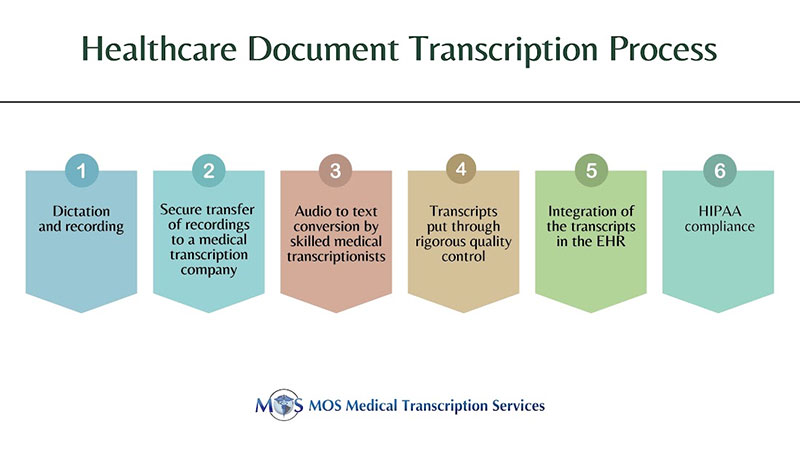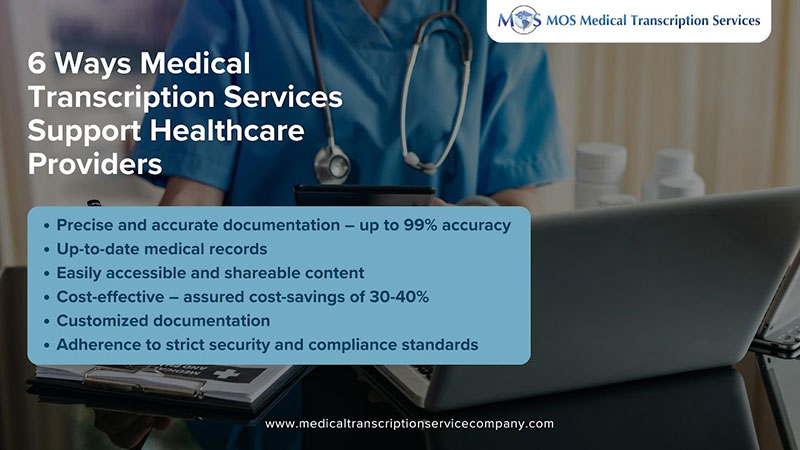
Table of Contents
Accurate and efficient healthcare documentation, as we know, plays a vital role in conveying crucial clinical information regarding a patient’s diagnosis, treatment, and results, as well as facilitating communication among healthcare professionals, providers, and payers. Good documentation also protects you from malpractice lawsuits. But documenting care comes with many challenges. In this blog, we discuss how medical transcription services have emerged as a vital tool in streamlining the recording, storage, and retrieval of critical medical information.
Challenges of Medical Record Documentation
Creating documentation is time-consuming, but it’s critical for your patient’s health. However, documenting and updating the patient’s electronic health record (EHR) usually takes up more time than you spend examining and interacting with them. A 2020 study in the Annals of Internal Medicine reported that physicians spend an average of 16 minutes and 14 seconds per patient encounter, with chart review (33%), documentation (24%), and ordering (17%) taking up most of that time – leaving you with less than 5 minutes for direct interaction with the patient.
An article published in MedCity News notes that the “real challenge with more efficient documentation is taking relevant subjective information from the patient, objective data from medical records, examination, and testing, and using expert clinical opinion to formulate a cohesive medical narrative of the entire encounter”.
Let’s dive into the problems associated with the healthcare documentation process.
Risk of Data Errors
It’s really important to keep records right. It’s easy to make mistakes when entering information into the EHR. You can use speech-recognition software to turn your dictated notes into written records. But if a scribe in your office makes a mistake when typing in the information, it can have potentially serious consequences. For instance, if a medication is transcribed incorrectly and this error is not detected, it can reach the patient and cause harm. To avoid these data errors and keep patient records correct, it’s a good idea to partner with a medical transcription company.
Complex Documentation
Different places use different computer systems for records, making things difficult for scribes who work with healthcare documents. This makes it tough for them to type or fix reports, and a lot of time and effort goes into getting everything right.
Not Using the Right Words
Accurate clinical documentation is vital to keep the care team informed about a patient’s condition, enabling gap identification and care adjustments. Healthcare providers must use precise language to describe patient acuity and complexity. A Beckers Hospital Review article cited a case in which prompt, life-saving treatment was given to a patient in hemorrhagic shock at an academic medical center. However, the diagnosis entry lacked ‘hemorrhagic shock,’ potentially affecting coding and reimbursement.
Not Including Patient Narratives
EMRs don’t capture a patient’s journey or a physician’s evolving interpretation. Physicians, busy with EMR data entry, may neglect the patient’s narrative. Using checkboxes and dropdowns is convenient but hinders diagnosis and treatment rationale. Suzanne Koven, MD, a primary care physician, stated, ‘A medical record that prioritizes lists dehumanizes patients and hampers diagnostic abilities.’ Clinical documentation should capture the patient’s story, critical for test and treatment decisions. Unclear or missing data can lead to diagnostic ambiguity and insurance claim rejections.
Technology Problems
Computers software can turn what you say into reports. But if your computer software isn’t updated or the internet connection is lost, it can lead to mistakes.
Given these challenges, medical transcription services have emerged as a vital tool for streamlining the recording, storage, and retrieval of critical medical information.
Understanding Healthcare Document Transcription

Medical transcription is a critical process that involves creating precise and timely documentation. It involves converting spoken or handwritten medical records, including patient histories, discharge summaries, clinical notes, and more, into accurate and organized text format. Healthcare document transcription involves several steps.
Physicians dictate and record patient information, including diagnoses, treatment plans, and notes, using voice recording devices or specialized dictation software.
These digital recordings are then securely transferred to a medical transcription company in the USA through an encrypted channel or cloud-based platform. Skilled medical transcriptionists with specialized training in medical terminology, transcribe the recorded dictations into written text using word processing software or specialized transcription software.
The transcribed documents go through a stringent quality control process, including proofreading, editing, and formatting, to ensure accuracy and compliance with healthcare documentation standards. If physicians use voice recognition technology that automatically converts voice recordings into text, human transcriptionists evaluate the transcripts for accuracy and contextual understanding.
By integrating the transcribed content into Electronic Health Records (EHR) systems or other healthcare databases, your practice can maintain accurate, up-to-date patient records.
How Medical Transcription Services Make the Difference

Having accurate and detailed documentation is crucial for efficient and seamless patient care. Medical transcription has evolved significantly from traditional manual methods to embrace advanced technology. When you choose a reliable service provider, you are assured of many benefits:
- 1. Precision in Documentation
Failing to transcribe physician notes accurately can result in incorrect patient records, potentially compromising patient care and safety. Experienced healthcare transcriptionists are trained to understand and transcribe complex medical terminology and jargon. They can ensure that medical records, patient histories, discharge summaries, and other essential documents are transcribed with precision and clarity.
- 2. Rapid Turnaround
As a medical professional, it’s likely you often struggle with time constraints and pressure due to paperwork alongside patient care. Medscape reveals that bureaucratic tasks, like charting and paperwork, rank high among burnout reasons. Transcription services streamline documentation. You record notes digitally, and expert transcriptionists ensure speedy, accurate transcriptions. Fast access to documents facilitates timely decision-making and patient care.
- 3. Accessibility and Portability
Integration with EHR systems ensures that transcribed data is seamlessly incorporated into a patient’s medical record, enhancing care continuity. You can easily access the clinical documents easily, anywhere and at anytime. The documentation can be shared across healthcare facilities, supporting multidisciplinary care and patient referrals.
- 4. Cost Efficiency
Outsourcing healthcare document transcription is a cost-effective solution that eliminates in-house challenges and costs. You save on salaries, benefits, training, software, equipment, and office space. Experienced transcriptionists reduce errors, while faster turnaround times expedite billing and boost revenue flow, while offering you the flexibility to adjust services as needed.
- 5. Customization
Transcription services can be tailored to meet the specific needs of your healthcare organization, ensuring that documents are formatted and structured as required. Furthermore, specialty-specific medical transcription services are tailored to meet the unique needs of different specialties, be it cardiology, radiology, orthopedics, dermatology, or others. Transcriptionists in specialty-specific services are well-versed in the complex medical terminology, jargon, and nuances of various specialties, ensuring accurate and context-aware transcriptions.
- 6. Compliance and Security
Healthcare document transcription services adhere to strict security and compliance standards, including HIPAA regulations, to protect the confidentiality of patient data. Not protecting your patient’s reports come at a high price. HIPAA compliance penalties include monetary penalties and lawsuits to criminal charges. The monetary penalties range from $127 to $250,000 depending on the nature of the HIPAA violation. Choosing HIPAA- compliant medical transcription services can help you avoid these issues. Reliable companies have a range of robust security measures in place to ensure the confidentiality of the patient information they handle.
Healthcare documents transcription offers a wealth of advantages for physicians, healthcare organizations, and ultimately, patients. With accurate and efficient documentation, you can enhance patient care, streamline administrative processes, and ensure compliance with regulatory standards. Partnering with an efficient company can ensure many benefits: precise and timely medical records, reduced administrative burdens, and a renewed focus on what matters most – delivering top-notch care to patients.


